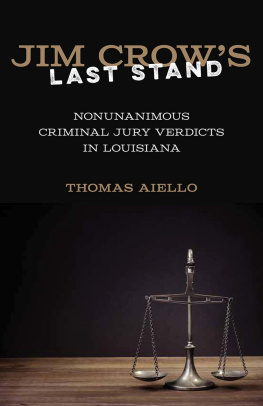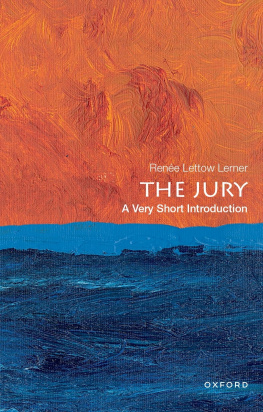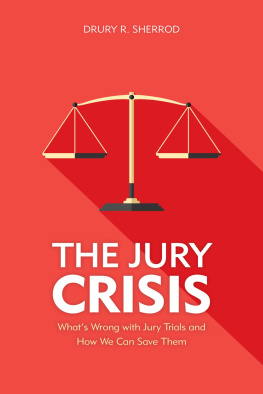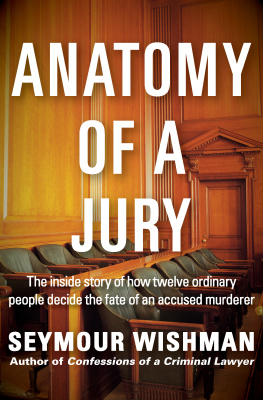Published by Louisiana State University Press
Copyright 2015 by Louisiana State University Press
All rights reserved
Manufactured in the United States of America
First printing
DESIGNER: Mandy McDonald Scallan
TYPEFACE: Whitman
PRINTER AND BINDER: Maple Press, Inc.
Library of Congress Cataloging-in-Publication Data Aiello, Thomas, 1977 author.
Jim Crows last stand : nonunanimous criminal jury verdicts in Louisiana / Thomas Aiello.
pages cm
Includes bibliographical references and index.
ISBN 978-0-8071-5899-9 (cloth : alk. paper) ISBN 978-0-8071-5900-2 (pdf) ISBN 978-0-8071-5901-9 (epub) ISBN (invalid) 978-0-8071-5902-6 (mobi) 1. JuryLouisiana. 2. Discrimination in criminal justice administrationLouisianaHistory. I. Title.
KFL581.A34 2015
345.763056dc23
2014018039
The paper in this book meets the guidelines for permanence and durability of the Committee on Production Guidelines for Book Longevity of the Council on Library Resources.

PREFACE
Louisiana still lives under a Jim Crow law. This is not a statement about the evolution of racism in the wake of civil rights and Black Power. It isnt a statement about the more esoteric problems of race-related realty abuses and housing prices; nor is it a statement about drug laws or the state of Louisiana prisons. There is no doubt that, even after the Civil Rights Act of 1964 and the Voting Rights Act of 1965 eliminated the racist mistakes of southern legislatures by ending state-sanctioned segregation and voting restrictions, racism still exists. School segregation suits still litter the courts, fueled by a residential segregation much harder to attack. And though all citizens can now vote without fear of reprisal, legislators still gerrymander electoral districts to devalue the votes of minorities. Still, though they depend indirectly on a legacy granted them by the post-Reconstruction era, those are the modern problems of the modern South.
There is a modern law that has a far more direct connection to the late-nineteenth century period of Redemption. Beginning in 1880, Louisiana allowed criminal defendants to be convicted by nine of twelve jurors. Today it allows them to be convicted by ten. It was a law designed to increase convictions to feed the states burgeoning convict lease system and remained in the first half of the segregationist twentieth century even after convict lease had run its course. As rights advocates of the 1950s and 1960s successfully challenged the ingrained racism of southern laws first conceived in the crucible of turn-of-the-century reactionary politics, they left nonunanimous criminal jury verdicts alone. The law is, among southern states, unique to Louisiana. Many never realized the law existed. Those who did were unaware of the laws genesis, its original purpose, or its modern consequences. And so it remained. It still remains. It is the last active law of racist Redeemer politics in Louisiana.
The 1972 U.S. Supreme Court decision Johnson v. Louisiana (1972), which narrowly validated the states criminal conviction policy, was born in Bourbon Louisiana. Its staying power has been demonstrated through constant legal challenge in the early twentieth century, its success in the Supreme Court, and its evolving role in modern criminal convictions in the late twentieth and early twenty-first centuries.
That said, this is not the stuff of law reviews and legal journals. Nonunanimous criminal jury verdicts have been gamely defended by Michael H. Glasser in the Florida State University Law Review and expertly criticized by Kate Riordan in the Journal of Criminal Law and Criminology. While those articles parse the various constitutional questions posed by nonunanimous criminal jury verdicts, they make no attempt to understand such laws in historical context and how that context bears on the function of those laws in practice over time. Certainly such constitutional questions are evaluated in the pages that follow, but that evaluation is situated against the backdrop of Louisianas racial legacy and the evolution of its criminal jury laws over the course of the states existence.
This is a work of history, not a political treatise. In every history of civil rights, however, no matter the claims of objectivity, there are inherent moral judgments that make themselves clear. No historian, for example, pretends that segregated bus depots were the result of neutral and understandable laws in the context of their time. No historian pretends that the assaults on Freedom Riders who entered those bus depots were battles between equals, each of whom had their own legitimate vested interests in the outcomes. Rather, in the course of an objective explanation of events, historians tease out a subjective argument about right and wrong, better and worse. Tactics are evaluated, strategies are critiqued, but everyone leaves the reading with the same impression of whom the good guys and the bad guys are.
The fallacy of early twentieth-century segregation laws was that, in service to racist assumptions, southern legislatures limited white development as much as they did black development because, as so many sociological studies have demonstrated, interracial contact tends to benefit everyone. Likewise, nonunanimous criminal jury verdicts were passed in service to those same racist assumptions. And they still have significant racial implications both for criminal defendants and for jurors. But they affect everyone. Anyone charged with a crime in Louisiana is more likely to be convicted than in any other state, save Oregon (which also has a nonunanimous criminal jury standard), by a factor of one in six. If someone is charged with a crime on the western bank of the Mississippi River, he or she has a 17 percent better chance of being convicted than if charged on the eastern bank, because the state of Mississippi requires jury unanimity. If a white man is charged with the murder of a black man in Louisiana, he has a 17 percent better chance of being convicted than if he had been charged with a hate crime under federal law, because the federal government requires jury unanimity. When it actually benefits Louisiana criminal defendants to be charged with hate crimes, the system is fundamentally flawed.
The history of nonunanimous criminal jury verdicts acts as its own advocate for ending the practice. What is most surprising about the Louisiana jury standard is that very few people outside of the legal profession seem to know that it exists. We live in a world of John Grisham novels and Law and Order episodes, where plots hinge on creating reasonable doubt in the mind of one juror, and so that standard becomes the common and reasonable assumption. But if a Louisiana defense attorney cant create reasonable doubt in the mind of three jurors, then the defendant will be convicted. Louisiana doesnt obey the rules of Law and Order, and that reality has fundamentally shaped its ability to maintain law and order.
I would like to thank Michael Martin, Shannon Frystak, Mary Farmer-Kaiser, and the students who came to hear us speak at the University of Louisiana at Lafayette for helping to clarify some of my thoughts on this project. Likewise, the members of the Louisiana Historical Association, Mary Howell, Gregory Richard, and Natalie J. Ring also provided valuable commentary. Thank you also to Hill Memorial Library at Louisiana State University, and, as always, to Madison French, Carol Fuller, and Pete Aiello for being who you are.






